Next step for decommissioning the College's reactor

The College's Reactor Centre has entered the next stage in its decommissioning, as Imperial submits a formal application to the regulator.
Last year the Reactor Centre staff worked closely with the nuclear and environmental regulators to ensure the safe removal of the fuel. The next step in the administration of the process is an application to the Office for Nuclear Regulation (ONR) for formal approval for decommissioning, to allow work to continue.
Our progress is down to the diligent work of the staff on the ground and the combined efforts of the various organisations who are supporting the process
– David Forbes
Project director for decommisioning the reactor
The process began in 2011 following the decision by the College Council to decommission the 100 kW CONSORT Reactor Mark II, following a significant decline in the volume of research conducted in the facility over the past decade and a half.
The decommissioning of the reactor, which is 10,000 times smaller than a nuclear power station, is a multi-staged process and will take over a decade to complete.
David Forbes, project director for decommissioning, said: “Even with such a small reactor, decommissioning is complex. Our progress is down to the diligent work of the staff on the ground and the combined efforts of the various organisations who are supporting the process . Hopefully disruption on campus has been kept to a minimum but we’re very grateful to the campus community for their patience.”
. Hopefully disruption on campus has been kept to a minimum but we’re very grateful to the campus community for their patience.”
As part of the formal application, the College has submitted an environmental statement to ONR, which presents an environmental impact assessment for the decommissioning project. This is available for the local community around Silwood Park to view in local libraries and on ONR’s website, with consultation concluding on 28 April 2015.
Article text (excluding photos or graphics) © Imperial College London.
Photos and graphics subject to third party copyright used with permission or © Imperial College London.
Reporter
John-Paul Jones
Communications and Public Affairs